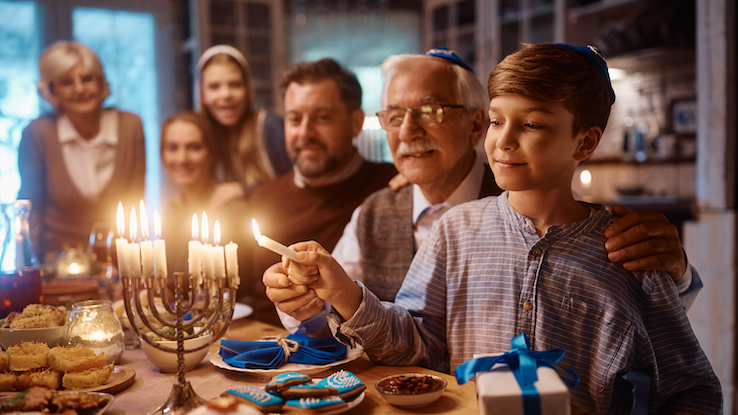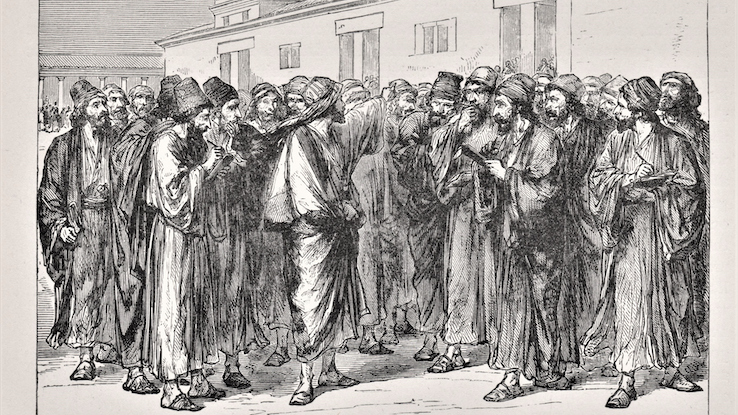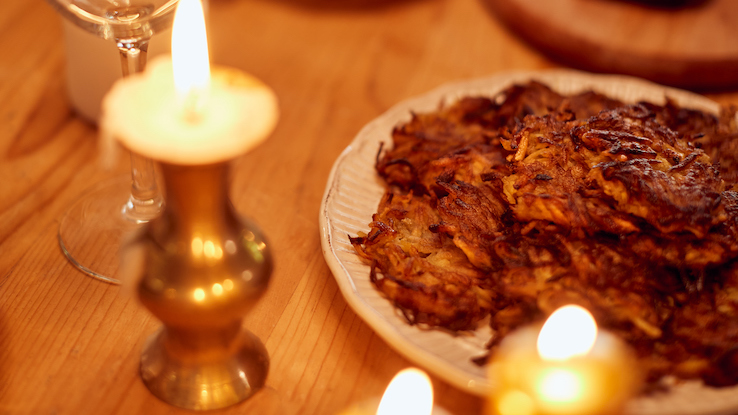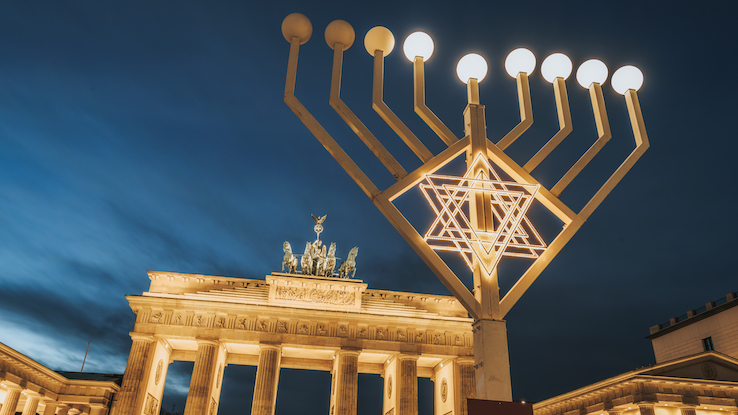
For eight days during the cold winter months, people who practice Judaism gather together to eat delicious food, sing lively songs, play exciting games and, most importantly, light candles on the menorah. These are some of the traditional activities that mark Hanukkah, a Jewish celebration of the rededication of Jerusalem’s Holy Temple. This holiday is also called the Festival of Lights, and it begins on the 25th day of a Hebrew month called Kislev, which often aligns with dates in November and December.
Hanukkah is a time of joy commemorating a miraculous event that took place centuries ago. In 2021, the holiday begins on the evening of Sunday, November 28, and ends on the evening of Monday, December 6. With Hanukkah on the horizon, let’s take a look at the story behind the eight-day celebration, including how the holiday began, and explore the traditions Jewish people around the world observe during the Festival of Lights.
What’s the Story Behind the Beginning of Hanukkah?

The story of Hanukkah begins with King Antiochus IV, a Greek ruler who reigned over Syria from 175 B.C. until 164 B.C. During that time, the area had two Jewish groups called the Hellenists and the Traditionalists.
The Hellenists were accepting of the dominant Greek culture that surrounded them, but the Traditionalists remained faithful to and continued to practice Judaism. King Antiochus wanted everyone under his rule to follow the same way of life, which included having everyone follow one religion. He planned to enforce this idea by banning the Traditionalists — and everyone else — from practicing Judaism. The king outlawed the religion and the cultural practices associated with it, and every Jewish person was ordered only to worship Greek gods. Antiochus also raided Jerusalem’s Holy Jewish Temple, setting up altars dedicated to Greek idols and gods like Zeus inside. Many Jewish people were afraid for their lives during this time, and some decided to follow the king’s orders.
One group, called the Maccabees, was determined not to let King Antiochus strip them of their religion or way of life. In response to the ruler’s orders, they revolted. Led by the Jewish priest Mattathias, the army of Maccabean warriors fought against Antiochus’ army and were eventually victorious in forcing the king and his soldiers out of Jerusalem. The determined Maccabees also restored the Temple, which the king had destroyed, by removing the Greek idols, rebuilding the space and cleaning it.
Once the Temple had been rebuilt, the Maccabees planned a grand ceremony rededicating the Temple to Judaism and to God — the word “hanukkah” comes from a Hebrew verb meaning “to dedicate.” After returning to the cleaned building, however, the Maccabees discovered that they only had enough oil to light the Temple’s menorah lamp for one day. They were unsure when they’d be able to get more oil for the ceremony — traditionally, the menorah required a ritually blessed type of olive oil that took a week to prepare. But miraculously, the oil they had on hand lasted for eight days and nights, which was the length of time it took the Maccabees to replenish their oil supplies. Today’s Hanukkah traditions honor many elements of the miracles that took place in this original story.
How Do People Celebrate Hanukkah Today?

Although its dates sometimes align with Christmas, it’s important to remember that Hanukkah isn’t a Jewish version (or even equivalent) of that Christian festival; it’s its own holiday with its own important meaning to Jewish people. Hanukkah was also traditionally one of the more minor observances in Judaism. But because it tends to fall around Christmastime (and even Thanksgiving in some years), it became a bit more commercialized, especially in the United States.
Although the Festival of Lights was typically a quieter observance and still is across much of the world, it’s also a holiday filled with important symbolism and traditions that hearken back to many elements of the original Hanukkah story. During the holiday, many Jewish people participate in these common Hanukkah customs.
Lighting the Menorah
The menorah is the type of candelabra the Maccabees kept lit for eight days on one day’s worth of oil. To commemorate this element of the Hanukkah story, Jewish people place small menorahs in their front windows at home. On each night of the holiday, just after sundown, they light candles on the menorah using a special “helper” candle called a “shamash” and recite several traditional Hebrew blessings.
Eating Fried Foods
Lighting the menorah isn’t the only Hanukkah tradition that represents the oil miracle. During the festival’s eight days, family and friends gather to share meals together — meals centering foods that are fried in oil. Potato pancakes called latkes and fried jelly doughnuts called sufganiyot are two of the most popular fried foods for Hanukkah.
Many people who celebrate the holiday also eat dishes like cheesecake and a Jewish casserole called kugel that incorporates several different kinds of cheese. These are also symbolic; they represent Judith, a heroine who assassinated the Syrian-Greek general Holofernes with the help of some very salty goat cheese.
Playing Dreidel Games
Before the Temple rededication when the Traditionalists were forbidden from practicing Judaism, some people continued to study sacred texts and worship secretly. When they feared getting caught, they quickly hid their reading materials and took out small tops to spin, pretending they’d been playing with the tops the entire time. These tops, called dreidels, frequently appear at Hanukkah celebrations, where kids play games with them to win pieces of chocolate money known as gelt.
Dreidels have four sides, and each side is inscribed with a Hebrew letter that stands for part of the saying “Nes gadol haya sham,” or “A great miracle happened there.” Each letter also tells players what action to take in the game as they take turns spinning the dreidel.
Hanukkah Around the World

Although Hanukkah features several common traditions, the ways people celebrate also differ around the world. For example, many Jewish people in Cuba use plantains instead of potatoes to make fried pancakes because these starchy, banana-like fruits are widely eaten around the island. This custom is also popular in Colombia and other countries around South America. In Syria, celebrations include lighting an additional shamash candle to show solidarity with refugees who were forced to flee the country.
In some areas of France, Jewish families use “double-decker” menorahs that can hold 16 lights instead of the traditional eight. These are designed so a parent and child can both light their own set of candles together. In Morocco, Hanukkah is celebrated for nine days, and the very last day is known as the day of the shamash. Children go door to door, collecting leftover Hanukkah candles to use in a bonfire that people take turns leaping over to bring good luck.
Like many other global holidays, part of the beauty of Hanukkah is that various cultures adapt and create traditions that reflect unique elements of their lifestyles and communities. But at the heart of them all is the reminder of an important miracle in Jewish history — a story of hope and a reminder to persevere.






